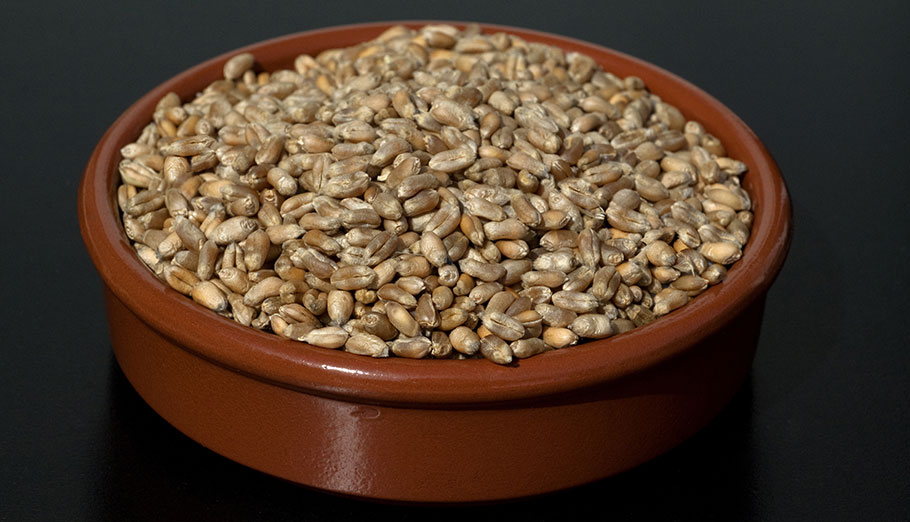Triticale

Overview (Has Gluten)
Triticale is a wheat (Triticum) and rye (Secale) hybrid developed in Scottish and Swedish laboratories in the 19th century. Due to its ability to grow in poor conditions, it is commonly cultivated to nourish livestock, although it is also used in breakfast cereals and milled for flour. Triticale is an excellent source of thiamine and magnesium and has more protein and lysine than wheat or rye, as well as a higher quality balance of amino acids.
Triticale berries have a pleasant flavor similar to wheat, with a touch of rye flavor. Flour milled from triticale is an excellent substitute/alternative to whole wheat flour and works well in virtually all baked goods. Triticale has less gluten than wheat flour, so it is recommended to use a half and half blend of wheat flour and triticale flour for leavened breads.
Incidentally, if you’re calling around to your local health food stores to see if they have this grain, it’s pronounced Trit –uh-CAY-lee.
Nutrition
Triticale flour is an excellent flour to blend with whole wheat flour due to its nutritional profile. Besides being low in saturated fat, sodium, and cholesterol, one cup of triticale flour has 76% of the recommended daily value of dietary fiber and 17 grams of protein per serving. It is also a good source of magnesium and iron. Feel free to experiment with pizza crusts and flatbreads.
Note: Weight of a cup (or partial cup) of flour varies depending upon whether it is lightly sprinkled into a measuring cup or compacted. Most recipe measurements are based on sifted flour as a way to arrive at more uniform measurement.
Gluten Content & Allergen Information
Because triticale is a wheat/rye hybrid, it is not suitable for anyone with wheat allergies or Celiac disease.
Nutrition Facts
| Serving Size | 1 Cup |
| Calories | 439 |
| Total Fat 2g | 3% |
| Cholesterol 0mg | 0% |
| Sodium 3mg | 1% |
| Carbohydrates 95g | 32% |
| Dietary Fiber 19g | 64% |
| Total Sugars 0g |
| Protein 17g |
| Vitamin D 0mcg | 0% |
| Calcium 46mg | 4% |
| Iron 3mg | 17% |
| Potassium 0mg | 0% |
* The % Daily Value (DV) tells you how much a nutrient in a serving of food contributes to a daily diet. 2,000 calories a day is used for general nutrition advice.
Diet Compatibility
Paleo Diet
The Paleo Diet seeks to emulate the hunter-gatherer diet of our stone-age ancestors. The emphasis is on wild plants and meats similar to what ancient man would have consumed. As such, dairy products, refined sugar and processed oils are off limits. While many Paleo Diet followers also avoid grains, there is ample archaeological evidence to show that grains were part of Paleolithic era man’s diet.
Compatibility with Triticale Flour:
Not Compatible

Mediterranean Diet
This diet seeks to emulate the diets of those living along the Mediterranean coast, with an emphasis on fresh fruits and vegetables, seafood/fish at least twice a week, limited servings of poultry, and only occasional sweets and red meat.
Compatibility with Triticale Flour:
Compatible

Gluten-Free Diet
As the name suggests, the gluten-free diet eliminates all foods with gluten. Although most of those on a gluten-free diet are on it out of necessity—either due to severe wheat allergies or Celiac disease—many have embraced a gluten-free diet as being healthier.
Compatibility with Triticale Flour:
Not Compatible

Macrobiotic Diet
Although there are many versions of macrobiotic diets, the common thread is that they emphasize natural, whole foods, grown locally and organically. Whole grains, vegetables, legumes, fruits, seeds and nuts, and occasional seafood are all integral to the diet. Red meats, dairy, poultry, eggs and processed foods are off the menu.
Compatibility with Triticale Flour:
Compatible

Acid Alkaline Diet
This diet aims to restore the slightly alkaline state of the body, which is believed to be ideal. By focusing on a diet high in vegetables, fruits, sprouted grains, lentils, almonds and soy products, the goal is to have a balance of 80% alkalizing foods and 20% acid forming foods.
Compatibility with Triticale Flour:
Compatible – Triticale Flour is condiered to be slightly acidic

Low-Carb Diet
As the name suggests, this diet focuses on reducing carbohydrates in the diet to lose weight. The theory is that by staying away from high-carb foods like pasta and bread and eating low carb, high fiber vegetables and fruits instead, your body will go into ketosis and you will lose weight. This diet is sometimes referred to as a ketogenic diet.
Compatibility with Triticale Flour:
Compatible in Very Limited Quantities

Atkins Diet
The Atkins Diet is a historically popular low carb diet, instructing dieters not to worry about their calories but to monitor and minimize their intake of sugar and carbohydrates. According to Dr. Atkins, depriving the body of its primary energy sources causes the body to burn fat.
Compatibility with Triticale Flour:
Compatible in Very Limited Quantities

“We love the mill! We use it every day for things from bread, to pastry and it is phenomenal. The biggest selling point for me was the fineness since that would mean we can really do some great pastry with it in addition to bread. It definitely has been great!"
BEN FROM NORTH CAROLINA

